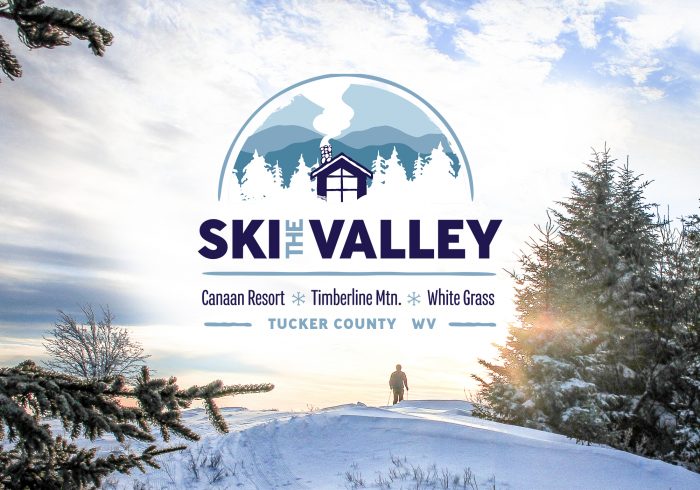Ski the Valley – Collaborative Project
Published: March 11, 2021Many destinations and organizations talk about the benefits of collaboration, but few take the needed action to see that through to fruition. When the Tucker County CVB expressed interest in revitalizing their “Ski the Valley” initiative, we were eager to work on this joint effort to bring renewed brand awareness and, ultimately, visitors to the area this ski season.
The Ski the Valley campaign has been around for years in Tucker County, WV. With two downhill ski resorts and a cross-country ski touring business in the small community, it has long been a way to encourage people to visit the area in the winter months and then come back time and time again.
“Ski the Valley has been in existence for a long time, but we had to recreate it to stay relevant,” explained Jessica Waldo, Tucker County Convention and Visitors Bureau’s executive director. “The key to Ski the Valley is the collaboration, and that’s what sets us apart. Where else can you go where there are two downhill ski areas and a cross-country ski area literally five minutes apart? So, if we work together, it only benefits each of us individually and as a whole.”
Cooperation > Competition
It’s challenging to bring people and organizations together. Whether working on a project with adjacent destinations or competing businesses, the road to a successful partnership can be littered with politics, ego, financial strain, creative differences, personality challenges just to name a few. There are things you can do to help identify quality partners and address common obstacles.
- Look for people and organizations that are already involved in the community and are publicly supportive of other businesses. These are folks who already understand that communities thrive when collaboration and encouragement are present. Getting buy-in for a collaborative campaign is easier with people who live this out in other areas.
- Find partners that appeal to a similar interest group or demographic. In the Ski the Valley example, the partnership included two downhill ski resorts, a cross country touring center and sledding and tubing parks. These may be competing businesses, but it is easy to understand that visitors staying 2-3 nights in a destination will likely visit multiple snow attractions and benefit the local economy in other ways by shopping, eating and with overnight stays.
- Include complementary businesses. If a destination has a strong presence for water attractions, not only the rental companies can partner, but look to include outfitters, nearby restaurants and locally-owned lodging to offer specials, cross-promotions and co-branded materials.
- Be clear and direct about financial arrangements, responsibilities and timeline. Agreeing upon the terms of the partnership and being open about what each partner can bring to the table is important to prevent unnecessary conflict down the road.
- Be nimble and work quickly. Many successful partnerships are formed out of necessity or when people see a big opportunity and act quickly. Being responsive to trends, such as the Ski the Valley initiative’s responsiveness to travelers seeking more outdoor activities in light of COVID-19, helps get a relevant message out to interested visitors when it will have the greatest impact.
- Be flexible. Working with multiple partners — often with strong opinions — can be challenging, especially for business leaders used to having to make decisions on their own. While nobody wants mistakes or sloppy work, being flexible about preferences is a key to keeping a project on track. Let go of the things that really don’t matter to the end result, and save strong opinions for winning when it really matters.
- Identify a point of contact for each organization involved and set deadlines and a clear approval process to streamline communication and decision making.
Ripple Effect
Working collaboratively, like in the case of the Ski the Valley campaign, is important because it benefits more than just the driving organizations in any area. This is true everywhere, but it is particularly noticeable in small towns.
“We’re unique because we have no chains, so all of our hotels, restaurants and ski areas are individual businesses that have to rely on other businesses to make it all work. The restaurants and breweries are here, in large part, because of the tourism product that’s available, which brings a captive audience. For example, the art movement in Thomas happened organically because there was streetfront space there at an affordable price, and there was already foot traffic coming to town visiting nearby tourist attractions,” said Waldo.
Some ways strategic partnerships impact a destination include:
- A boost to adjacent businesses, such as restaurants, smaller attractions and overall foot traffic in towns.
- An elevated opinion of an area because of smart, well-researched, well-designed marketing campaigns.
- Over time, initially more reticent people and businesses become open to the idea of collaborative partnerships once they see the benefits and success of working together.
The Results
With the ongoing impacts of COVID-19 and early winter spike in cases, many winter destinations were unsure of whether visitors would show up even for safe, socially distanced outdoor activities. Many outdoor destinations enjoyed steady visitation this season, and that is especially true in Tucker County, which had one of the strongest ski seasons in recent memory. We are confident that the rebranding of the Ski the Valley campaign will continue to grow in coming years.
The benefits of collaborative projects are not unique, however, to the unusual circumstances we found ourselves in during 2020-2021. With hard work, creativity, and an approach that values collective ideas, destinations and other industries can bring added value to guests, add to a partner’s bottom line, and enhance the sense of community.
“Every weekend was sold out consistently. It brought back the buzz to the Valley — everybody locally had been down in the dumps, and now we’re all giddy and excited. It brings life back to the Valley and you can see that in the community,” explained Jessica Waldo.


